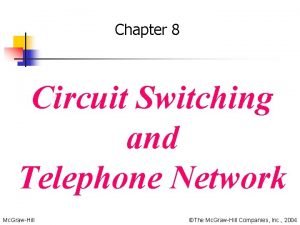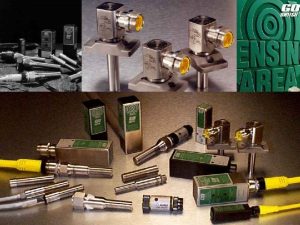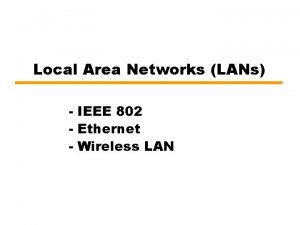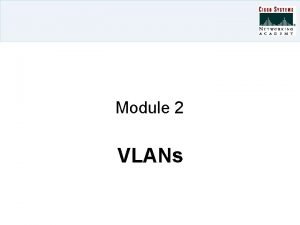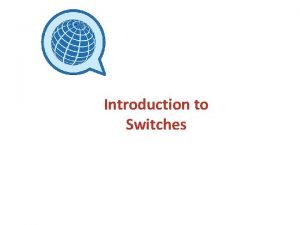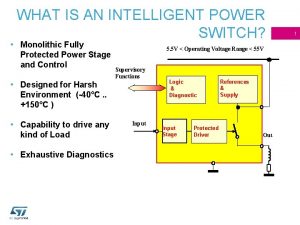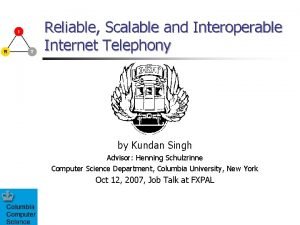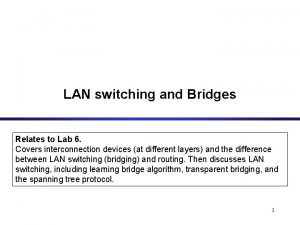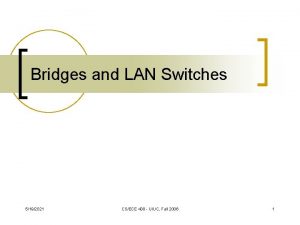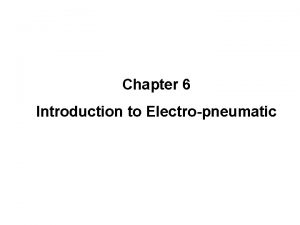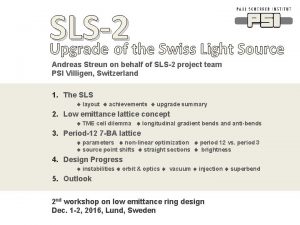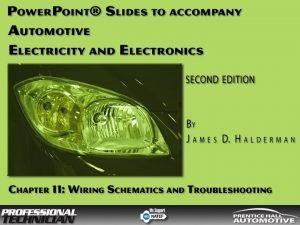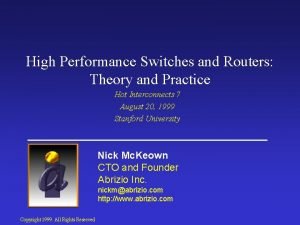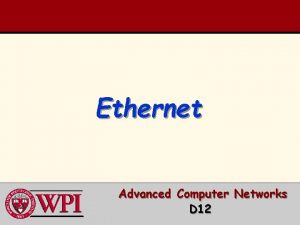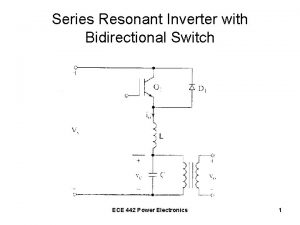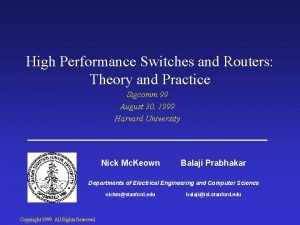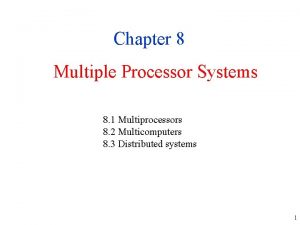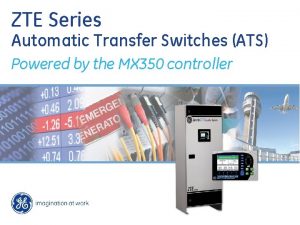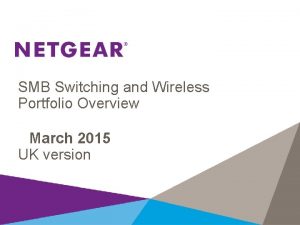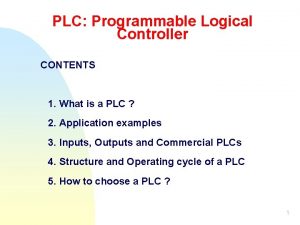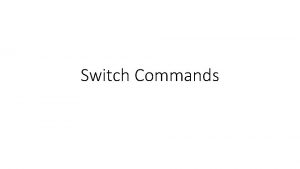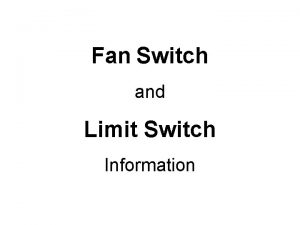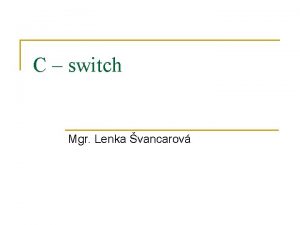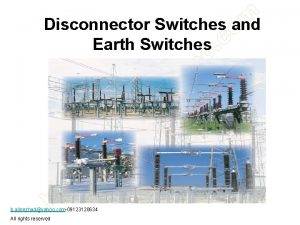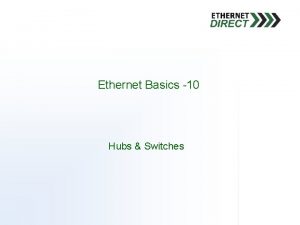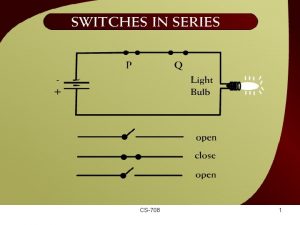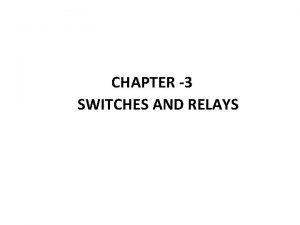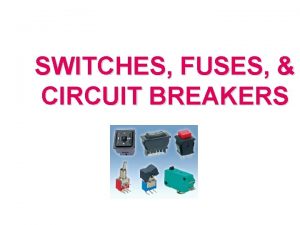Introduction to Switches Switch Access Switches are simple










































- Slides: 42

Introduction to Switches

Switch Access • Switches are simple buttons that can be pressed to access a communication aid. • Just one button provides complete access to all symbols and device functions through a system known as scanning. 2

How does the Switch Work? • Works in a similar manner to Partner Assisted Scanning. • The computer scans through each symbol on screen, one at a time. • This can usually be seen with a visual highlight, but some people also have the symbol read aloud to help. • When the desired symbol is highlighted by the computer, the user hits the switch to select it. 3

Types of Switch There a lot of switches available. The vary mostly on the part of the body used to press the switch, and the movement of that body part. This image shows a red specs switch which the user accesses by moving his head to the right. 4

Types of switch The girl In this photograph is using a buddy button with her hand. The buddy button is also suitable for positioning on a wheel chair by a knee or an elbow. It can also work by foot. 5

Types of Switch • The wobble switch is useful for children who use large arm movements to press the switch. • The whole top column of the switch ‘wobbles’ in any direction when hit. • The large surface area is difficult to miss! 6

Types of Switch • • • The Sip & Puff switch is suitable to people with good breath control and who find it difficult to use other switches. The switch is actually two switches (one for sipping and one for puffing). Children with tracheotomies can still use sip and puff switches if they can control their cheek muscles. 7

Simple scanning In simple scanning the computer highlights one symbol at a time. The child presses their switch when the symbol they want is highlighted. It usually takes 1 -5 seconds to pause at each symbol. Timing skills and reliable movements are critical! 8

Simple scanning In simple scanning the computer highlights one symbol at a time. The child presses their switch when the symbol they want is highlighted. It usually takes 1 -5 seconds to pause at each symbol. Timing skills and reliable movements are critical! 9

Simple scanning In simple scanning the computer highlights one symbol at a time. The child presses their switch when the symbol they want is highlighted. It usually takes 1 -5 seconds to pause at each symbol. Timing skills and reliable movements are critical! 10

Simple scanning In simple scanning the computer highlights one symbol at a time. The child presses their switch when the symbol they want is highlighted. It usually takes 1 -5 seconds to pause at each symbol. Timing skills and reliable movements are critical! 11

Simple scanning In simple scanning the computer highlights one symbol at a time. The child presses their switch when the symbol they want is highlighted. It usually takes 1 -5 seconds to pause at each symbol. Timing skills and reliable movements are critical! 12

Simple scanning In simple scanning the computer highlights one symbol at a time. The child presses their switch when the symbol they want is highlighted. It usually takes 1 -5 seconds to pause at each symbol. Timing skills and reliable movements are critical! 13

Simple scanning In simple scanning the computer highlights one symbol at a time. The child presses their switch when the symbol they want is highlighted. It usually takes 1 -5 seconds to pause at each symbol. Timing skills and reliable movements are critical! 14

Simple scanning In simple scanning the computer highlights one symbol at a time. The child presses their switch when the symbol they want is highlighted. It usually takes 1 -5 seconds to pause at each symbol. Timing skills and reliable movements are critical! 15

Actvity • Imagine a young girl with cerebral palsy. It takes her 3 seconds to reliably make the movement required to press the switch. • We need to pause on each symbol long enough for her to be able to make this movement, so we allow 4 seconds. • In the previous group of symbols how long would it take to get to the mouse? 16

Making Scanning Faster • Scanning is usually slow compared to the other access options. However, there are ways to make it much faster, such as ensuring that the symbols are laid out on the screen so the most often used require less time and switch presses to get to them. • Whole row and column scanning is often used to reduce the time to get to • Symbols can also be grouped, and so the groups are scanned before the symbols within each group. 17

Row/Column Scanning Row and column scanning is much more efficient compared to stepping through each symbol one at a time. For single switch users it requires two presses instead of one (one for the row and then the second for the symbol). 18

Row/Column Scanning Row and column scanning is much more efficient compared to stepping through each symbol one at a time. For single switch users it requires two presses instead of one (one for the row and then the second for the symbol). 19

Row/Column Scanning Row and column scanning is much more efficient compared to stepping through each symbol one at a time. For single switch users it requires two presses instead of one (one for the row and then the second for the symbol). 20

Row/Column Scanning Row and column scanning is much more efficient compared to stepping through each symbol one at a time. For single switch users it requires two presses instead of one (one for the row and then the second for the symbol). 21

Elimation Scanning • Elimination switch access removes the standard scanning element altogether and instead uses nonlinear switch presses to navigate to the desired symbol. • It does this by dividing the symbols into two groups and then subdividing the group when the appropriate switch is pressed. • This is a feature in the Grid 3 software 22

Elimination Scanning Elimination scanning divides the collections of symbols on the page into at least two colours. Each colour represents a switch (so you need to use at least two switches for this to work). To select the owl we simply press the switch that corresponds to the colour behind the owl (blue!) 23

Elimination Scanning Now the blue half has been subdivided into two new halves, again using the same two colours which represent the two switches. The owl is still in the blue area so we press the blue switch again. 24

Elimination Scanning Press the blue switch again… 25

Elimination Scanning This time the owl is highlighted with the orange colour, so we must his the switch that corresponds to orange this time. 26

Elimination Scanning Another blue… 27

Elimination Scanning And finally orange will select the owl. This selection took six switch presses to get to the owl. 28

Activity • Consider the elimination scan and the standard scanning. • Why might you choose one over another for a child that you are working with? 29

The Importance of Positioning • • The Microlight is a very useful switch for people with very little movement, requiring just 0. 7 cm of movement to activate the switch. Often the microlight is positioned on its side, so a little movement in the tip of a finger resting on a desk is enough to operate it. But here there is no tolerance for error! The switch must be placed very accurately in order for it to work. How do we position such switches? Velcro! 0. 7 cm 30

Velcro & Dycem • • • Maxess trays are Velcro boards that come in a range of sizes to fit wheelchair trays. You can also stick Velcro directly onto wheelchair trays or tables. Dycem also stops switches from moving around, but is not a strong as Velcro and works best with heavier switches. 31

Positioning Switches It’s almost always preferable to use the hands to access the switches if possible. Think about where you would place a switch for children who are able to consistently make the following movements: • • • extend elbow to move forearm (like banging a drum) move forearm at elbow (like using a pencil eraser) rotate hand (from palm down to palm up) make a hand wave make a door knocking movement make a pointy finger or stick thumb out 32

Positioning Switches If you can’t find a reliable hand or arm position then have a think about the head and legs. Think again about where you would place a switch for these movements: • • • nodding head rotating head (like a ‘no’ movement) tipping head from side to side pushing knees out to the sides (and bringing them back!) tapping a foot 33

Positioning Switches Just because someone can hit a switch doesn’t mean it’s in the best position! You need to consider aspects such as: • • • How much effort is required to hit the switch? Can they hit it in a timely manner? Does it cause their pelvis to move? Does it result in lots of other unwanted movements? Does the child like the position of the switch? Is it practical to mount the switch in the position you’ve chosen? 34

Helping choose a switch position • • Affective Communication analysis Complexneeds. org. uk • ACA Observation Sheet 35

Mounting Switches • • • Switches are often mounted to headrests for head control, to the wheelchair seat for knee control, and to the foot rests for foot control. The L 3 D mounts from Rehadapt allow switches to be positioned very accurately The Meru Flexi mount allows for changes in position as the switch can be moved without tools 36

Stephen Hawking used a small infrared switch carefully positioned on a mount on his glasses. The tolerance for the position of this switch is tiny, but Hawking had staff with him who were trained to reposition it when necessary. 37

Switch Selection Tool You can download this tool to help guide you through Selcxting and using a switch for access and AAC Start Switch Guide 38

Switch Progression The more accurate and confident a child becomes in using a switch the greater the range of options they have to use that switch in different ways. Communication and Control are two of the most popular. SENswitcher demonstrates clearly a switch progression for use in different settings It is based on switch control skills SENswitcher This can also be downloaded from Global Symbols 39

Connecting a Switch to a device Connecting a switch to any sort of a device requires an interface The connection can be physical with a cable and interface box Or it can be wireless such as Bluetooth There are many options for connecting a switch to a computer How do we connect a switch to our Tablet 40

Connecting a Switch to a device Switch Interface Box Tablet Bluetooth Enabled Switch Bluetooth Connection Paired Tablet 41

Switch Games • • Making using a switch fun is important Give the child something that is motivating to practice accoueacy and timing This can be fun for families http: //oneswitch. org. uk/is a great resource for free switch games for PC’s Here are some great examples for older computers Start Light. Box for windows Start Star Wars Start Whack a Mole 42
 Insidan region jh
Insidan region jh The resources need to be reserved during the setup phase in
The resources need to be reserved during the setup phase in A switch combines crossbar switches in several stages
A switch combines crossbar switches in several stages Go switch limit switch
Go switch limit switch Switch router access point
Switch router access point Switch access trunk
Switch access trunk Access switch statement
Access switch statement Terminal access controller access-control system
Terminal access controller access-control system Terminal access controller access-control system
Terminal access controller access-control system Simple machines in bedroom
Simple machines in bedroom How to make a simple circuit with a paperclip switch
How to make a simple circuit with a paperclip switch Vni4140
Vni4140 Three generations of packet switches
Three generations of packet switches Kundan switches models
Kundan switches models Which chemical reaction switches 2 elements
Which chemical reaction switches 2 elements Bridges vs switches
Bridges vs switches Cisco rvs4000 throughput
Cisco rvs4000 throughput Cisco 100 series switches
Cisco 100 series switches Bridges vs switches
Bridges vs switches Electro pneumatic relay
Electro pneumatic relay Mercury switches in cars
Mercury switches in cars Radiall rf microwave switches
Radiall rf microwave switches All switches illustrated in schematics are
All switches illustrated in schematics are High performance switches
High performance switches Switched pdu
Switched pdu Unica solutions
Unica solutions Series resonant inverter with bidirectional switches
Series resonant inverter with bidirectional switches High performance switches and routers
High performance switches and routers Multiple processor systems
Multiple processor systems Zenith automatic transfer switches
Zenith automatic transfer switches Netgear gsm/fsm fully managed switches
Netgear gsm/fsm fully managed switches Refurbished netgear gsm/fsm fully managed switches
Refurbished netgear gsm/fsm fully managed switches Plc
Plc We should not touch electric switches with wet hands. why
We should not touch electric switches with wet hands. why High performance core router
High performance core router Present simple present continuous past simple future simple
Present simple present continuous past simple future simple Present simple past simple future simple
Present simple past simple future simple Simple past simple present simple future
Simple past simple present simple future презент перфект упражнения
презент перфект упражнения Simple present simple future
Simple present simple future Future simple in the past
Future simple in the past Tense chart for class 3
Tense chart for class 3 Presente simples de work
Presente simples de work


